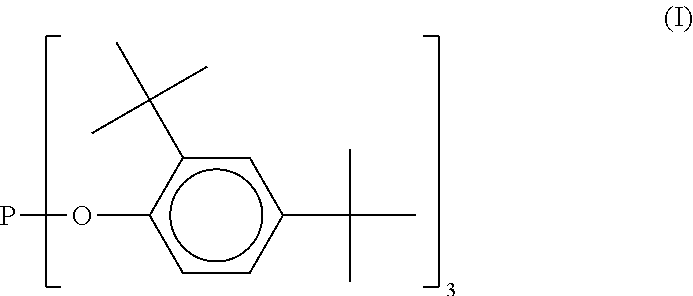Solid alkylaryl phosphite compositions and methods for manufacturing same
a technology of solid alkylaryl phosphite and composition, which is applied in the field of new solid alkylaryl phosphite antioxidants, can solve the problems that the tris(2,4-di-t-butyl)phosphite is not well-suited for the stabilization of all polymers, and achieves the effects of low melting range, high use value and convenient processing
- Summary
- Abstract
- Description
- Claims
- Application Information
AI Technical Summary
Benefits of technology
Problems solved by technology
Method used
Image
Examples
example 1
Solid Phosphite Prepared from a Mixture of 4-tert-Butylphenol and 2,4-Di-tert-butylphenol
[0145]2,4-Di-tert-butylphenol (93.3 g, 0.45 mols), 4-tert-butylphenol (17.0 g, 0.11 mols) and N,N-di-methyl-dodecylamine (2.47 mls, 9 mmols) were charged to an oil jacketed flask and heated to 90° C. under nitrogen. PCl3 (25.0 grams, 0.18 mols) was added, below the surface of the phenolics, at a uniform rate over three hours. During the addition, the temperature was ramped to 150° C. The reaction mass was held at 150° C. until HCl evolution ceased, and then heated to 200° C. over one hour while the pressure was reduced from 1000 to 50 mbar. The reaction was held at 200° C. / 50 mbar until the total Cl content was less than 50 ppm. The phenolic excess and amine catalyst are then removed by distillation under 1 mbar pressure and an internal temperature of 225° C. The molten material was cast and allowed to cool to room temperature. During cooling, the mixed phosphite composition solidified. Yield=97...
example 2
Solid Phosphite Prepared from a Mixture of 4-tert-Butylphenol and 2,4-Di-tert-butylphenol
[0150]2,4-Di-tert-butylphenol (108.25 g, 0.52 mols), 4-tert-butylphenol (8.75 g, 0.06 mols) and N,N-di-methyl-dodecylamine (2.47 mls, 9 mmols) were charged to an oil jacketed flask and heated to 90° C. under nitrogen. PCl3 (25.0 grams, 0.18 mols) was added, below the surface of the phenolics, at a uniform rate over three hours. During the addition, the temperature was ramped to 150° C. The reaction mass was held at 150° C. until HCl evolution ceased, and then heated to 200° C. over one hour while the pressure was reduced from 1000 to 50 mbar. The reaction was held at 200° C. / 50 mbar until the total Cl content was less than 50 ppm. The phenolic excess and amine catalyst were then removed by vacuum distillation. The molten material was cast and allowed to cool to room temperature. During cooling, the mixed phosphite composition solidified. Yield=80.3 grams.
[0151]HPLC analysis revealed that the com...
example 3
Solid Phosphite Prepared from a Mixture of 4-tert-Amylphenol and 2,4-Di-tert-amylphenol
[0155]2,4-Di-tert-amylphenol (117.1 g, 0.50 mols), 4-tert-amylphenol (9.1 g, 0.06 mols) and N,N-di-methyl-dodecylamine (2.47 mls, 9 mmols) were charged to an oil jacketed flask and heated to 90° C. under nitrogen. PCl3 (25.0 grams, 0.18 mols) was added, below the surface of the phenolics, at a uniform rate over three hours. During the addition, the temperature was ramped to 150° C. The reaction mass was held at 150° C. until HCl evolution ceased, and then heated to 200° C. over one hour while the pressure was reduced from 1000 to 50 mbar. The reaction was held at 200° C. / 50 mbar until the total Cl content was less than 50 ppm. The phenolic excess and amine catalyst were then removed by vacuum distillation. The molten material was cast and allowed to cool to room temperature. During cooling, the mixed phosphite composition solidified. Yield=84.9 grams.
[0156]HPLC analysis revealed that the compositi...
PUM
| Property | Measurement | Unit |
|---|---|---|
| weight percent | aaaaa | aaaaa |
| weight percent | aaaaa | aaaaa |
| weight percent | aaaaa | aaaaa |
Abstract
Description
Claims
Application Information
 Login to View More
Login to View More - R&D
- Intellectual Property
- Life Sciences
- Materials
- Tech Scout
- Unparalleled Data Quality
- Higher Quality Content
- 60% Fewer Hallucinations
Browse by: Latest US Patents, China's latest patents, Technical Efficacy Thesaurus, Application Domain, Technology Topic, Popular Technical Reports.
© 2025 PatSnap. All rights reserved.Legal|Privacy policy|Modern Slavery Act Transparency Statement|Sitemap|About US| Contact US: help@patsnap.com



